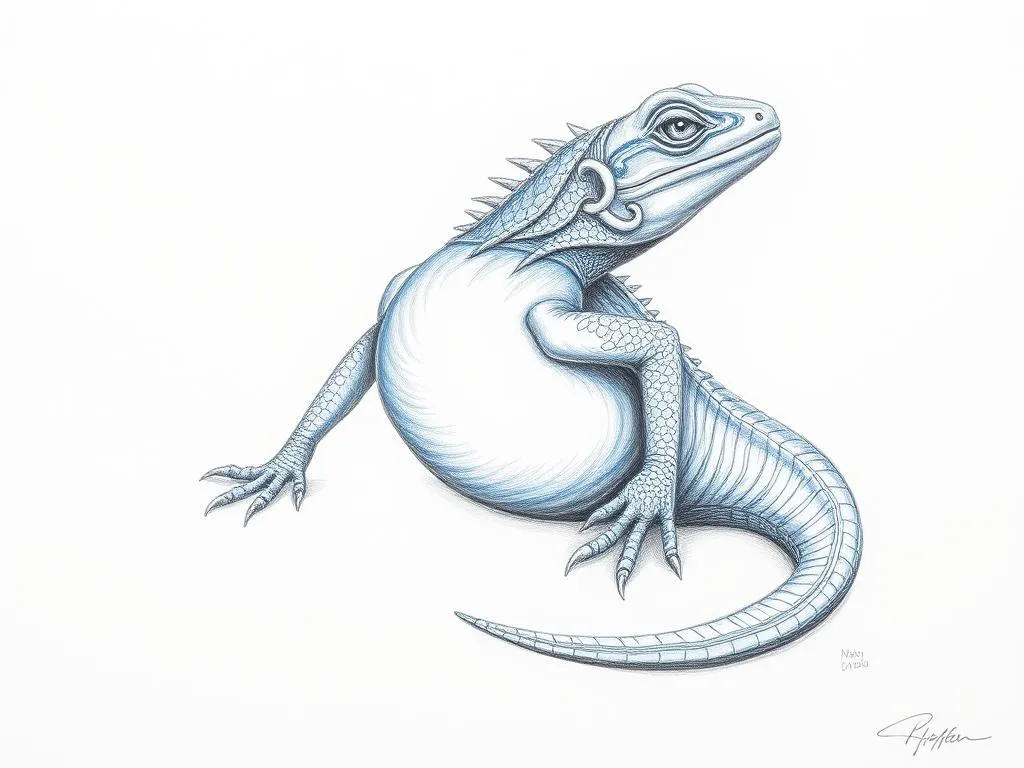The Blue Belly Lizard: A Symbol of Transformation and Adaptability

Disclaimer: Some images on this website are AI-generated artworks and may not accurately represent real animals.
The blue belly lizard, also known as the western fence lizard, is a captivating creature that thrives in various habitats across the western United States. Beyond its striking appearance, this lizard carries profound symbolism and meaning, particularly associated with transformation and adaptability. In this blog post, we will delve deep into the characteristics of the blue belly lizard, its ecological role, and the rich tapestry of meanings it holds in various contexts.
Understanding the Blue Belly Lizard
Physical Characteristics
The blue belly lizard is easily recognizable due to its vibrant blue coloration on its belly, which contrasts sharply with its more muted dorsal colors. Here’s a detailed look at its physical attributes:
| Characteristic | Description |
|---|---|
| Length | 5 to 8 inches (12 to 20 cm) |
| Coloration | Dark brown or grayish with bright blue underbelly |
| Tail | Long and slender, often used for balance |
| Skin | Rough and scaly, providing protection |
| Eyes | Large, round, and often appear alert |
These lizards predominantly inhabit the dry, sunny areas of California, Oregon, and Nevada, preferring open woodlands, grasslands, and rocky terrains. Their behavioral patterns are equally fascinating; they are known for their quick reflexes and agile movements, often darting away to avoid predators. During the day, they bask in the sun, absorbing warmth which is essential for their metabolic functions.
Ecological Role
The blue belly lizard plays a vital role in its ecosystem. As both predator and prey, it contributes to maintaining the balance within its habitat. These lizards primarily feed on insects, such as spiders and beetles, helping to control pest populations.
In terms of predation, blue belly lizards are often hunted by birds of prey, snakes, and larger mammals. This predator-prey relationship is crucial for the ecological dynamics of their environments. Their presence indicates a healthy ecosystem, as they thrive in areas with abundant food and proper climatic conditions.

Symbolism & Spiritual Meaning
Transformation and Change
The blue belly lizard is a powerful symbol of transformation. Its ability to shed its skin aligns with the concept of metamorphosis, making it a representative of personal growth and renewal. In various cultures, lizards are considered to embody the spirit of change, encouraging individuals to embrace life’s transitions.
For many, this symbolism translates into the notion that change is not only inevitable but also a vital part of one’s journey. Whether it’s overcoming personal challenges or adapting to new circumstances, the blue belly lizard serves as a reminder that embracing transformation can lead to profound personal development.
Adaptability and Resilience
Adaptability is another key trait associated with the blue belly lizard. These lizards can thrive in a variety of environments, showcasing their resilience and flexibility. This adaptability serves as an inspiration for individuals facing challenges, reminding us that with the right mindset, we can navigate difficult situations and emerge stronger.
In spiritual contexts, the blue belly lizard encourages a connection with one’s surroundings, urging individuals to remain grounded while embracing change. This creature is a symbol of overcoming obstacles and thriving despite adversity, reinforcing the idea that resilience is a fundamental aspect of life.
Connection to the Earth
The grounded nature of the blue belly lizard signifies a deep connection to the earth. As a creature that spends much of its time in natural settings, it represents stability and the importance of being in tune with the natural world. For spiritual seekers, the blue belly lizard encourages grounding practices, such as mindfulness and meditation, which foster a deeper relationship with the earth and its elements.
Moreover, its relationship to the sun emphasizes the significance of warmth, vitality, and life-giving energy. The blue belly lizard reminds us that we are part of a larger ecosystem and that nurturing this connection can enhance our spiritual journeys.
Blue Belly Lizard in Dreams
Common Dream Scenarios
Dreaming of the blue belly lizard can evoke a variety of interpretations, often tied to themes of transformation and adaptability. Here are some common dream scenarios involving this lizard:
| Dream Scenario | Symbolic Meaning |
|---|---|
| Lizard appearing in a garden | Growth and new beginnings |
| Chasing a blue belly lizard | Pursuing change or confronting fears |
| Observing a lizard basking in the sun | Embracing relaxation and enjoying the moment |
| Lizard shedding its skin | Letting go of the past and embracing renewal |
These scenarios each hold their unique meanings, reflecting the dreamer’s current life situation and emotional state.
Personal Insights
When you dream of the blue belly lizard, it can serve as a reflection of your inner transformation. The lizard’s ability to adapt and change can highlight your capacity for personal growth and resilience. Such dreams may encourage you to tap into your intuition, urging you to recognize the potential for change within yourself.
By paying attention to these dreams, you can gain insights into your subconscious mind. The blue belly lizard becomes a powerful ally in your journey toward embracing adaptability and transformation, guiding you as you navigate life’s transitions.
Modern Interpretations
Cultural Significance
In contemporary society, the blue belly lizard has found its place in popular culture and media. Its vibrant colors and intriguing characteristics have inspired artists, filmmakers, and writers alike. The lizard often symbolizes themes of resilience, change, and the spirit of nature, resonating with audiences seeking deeper connections with wildlife.
Moreover, the representation of the blue belly lizard in environmental discussions highlights the importance of preserving natural habitats. As an indicator species, its health reflects the overall state of the ecosystem, making it a critical player in conservation efforts.
Symbolism in Art and Literature
The blue belly lizard has also made its mark in art and literature, where it symbolizes various themes related to transformation and adaptability. Artists often use the lizard’s vibrant colors to represent the beauty of nature and the importance of change in our lives.
In literature, characters associated with lizards often embody qualities of resilience and resourcefulness. These narratives encourage readers to reflect on their journeys, inspiring them to embrace transformation and adaptability as they navigate their paths.
Key Takeaways
- The blue belly lizard symbolizes transformation, encouraging personal growth through change.
- Its adaptability serves as a powerful reminder of resilience and the importance of thriving in adversity.
- The lizard’s connection to the earth emphasizes grounding practices that enhance spiritual journeys.
- Dreams featuring the blue belly lizard can reflect inner transformation and the potential for change.
- Modern interpretations of the lizard highlight its role in cultural narratives and environmental conservation.
Conclusion
The blue belly lizard is more than just a fascinating creature; it embodies profound meanings that resonate with our personal and spiritual journeys. Its symbolism of transformation and adaptability serves as a guiding light, encouraging us to embrace change and cultivate resilience in our lives.
As we explore our connections with nature, the blue belly lizard invites us to reflect on our own journeys, urging us to recognize the beauty in transformation and the power of adaptability. Whether encountered in dreams or in the wild, this vibrant creature remains a compelling symbol of life’s ongoing evolution.







